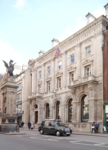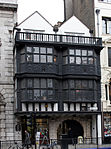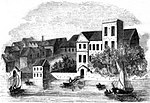Pump Court

Pump Court, Temple, London was the first on the left in Middle Temple Lane from 6 Fleet Street, leading to Inner Temple Lane and Lamb's Buildings. Its name referred to the pump in the middle.In the year following 1 Car 1 (1625), brick buildings were erected in the Pump Court. In 1637 (13 Car 1), the rest of the brick buildings in the Pump Court were set up.Many famous figures have lived in Pump Court including William Blackstone, William Cowper, Henry Fielding, Lord Russell of Killowen and Viscount Alverstone, his successor as Lord Chief Justice of England. There is a sundial with a motto that reads "shadows we are and like shadows depart" to remind the residents of the ephemeral character of their occupancy. This sun dial was put up in 1686, and there is an entry in the accounts in respect of it which reads "25th Nov. 1686 Sun Dial in Pump Court £6. 5. 0." It is renovated periodically, and on each of these occasions it was customary for the year and the initials of the Treasurer for the time being to be placed in the centre of the dial. It was restored in 1861. After it was renovated and repainted in 1903, the inscription in the centre read "T. Sir R. B. F. 1903" the Treasurer of the Middle Temple for that year being the Attorney General, Sir Robert Finlay. The insignia of the Middle Temple, the Lamb and Flag, "stood out very boldly" in gold at the top, and the motto was at the bottom. The inscription in the centre was subsequently replaced with "T O M 1686".
Excerpt from the Wikipedia article Pump Court (License: CC BY-SA 3.0, Authors, Images).Pump Court
Pump Court, City of London
Geographical coordinates (GPS) Address Nearby Places Show on map
Geographical coordinates (GPS)
| Latitude | Longitude |
|---|---|
| N 51.5129 ° | E -0.111 ° |
Address
Pump Court
Pump Court
EC4Y 7AJ City of London
England, United Kingdom
Open on Google Maps










